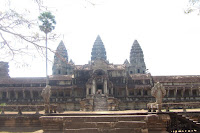
Travel Date 9th March 2008
Click on any picture to see a large version.
By now I expected the crowd selling water, photos, and peeled and decoratively scored pineapples, and tuk-tuk drivers at the entrance but they were much less of a problem than those at the entrance to the Bangkok Grand Palace had been.
We seemed to have picked a good time early in the morning; not much of a crowd at the ticket centre. I paid my US$20, had my picture taken and received my ticket with the picture on it. All very high-tech.


On to Angkor. And it was no anti-climax. It was magnificent. As you approach, the first thing you notice is the moat. Not one of your puny European efforts - this moat was wide and deep.

To arrive at the entrance a wide, long causeway must be crossed. This wedding party arrived as I did; gloriously dressed for the occasion with the bridal party to the fore.


Unfortunately for the photos the entrance faces West and I was there in the morning, hence the shadows.



However, that may have been why it was uncrowded. A price worth paying – and the East entrance looks just as good to me. That is the large picture at the top of this page.






Despite the depredations of the jungle, many wars, some clumsy recent restorations and antiquity vandals over the centuries the architecture, decorations and designs are still breath-taking. Sadly though, many of the statues had been decapitated by those vandals.



The lack of crowds enabled me to do what I like most in places like this. To wander at my own pace, stop and spend time reading the book on Angkor I borrowed from the guest house, relate it to the structure, or statue, or bas-relief in front of me and to move on at leisure. Occasionally I would just find a spot to sit and muse on past civilisations. Inconsequential things. Like why did people who were generally 30cm shorter than me build such high risers into their steps and stairs that I needed to step high to climb them. That thought also occurred to me later in Egypt and Mexico.




As usual I’ll let the pictures tell most of the story, with an occasional caption.
But first, a brief history comment to set the stage. I was surprised when my reading showed such a strong Indian and Sri Langkan influence on the Khmer kingdom during the Angkor period. This was partly because of the strategic position of the Mekong Delta and the Isthmus of Kra in the trade between India and China during that period. Conflicts far to the North interfered with the land Silk Road route and made the sea routes more important.


About 790 AD the area was loosely ruled from Java and a new King who had been imprisoned in Java took control; he was Jayavarman II. Java and most of Indonesia had been under Indian or Sri Langkan control prior to that time, so Jayavarman II brought many of the sub-continent's ideas and religious influences with him. He added to those by introducing the concept of the monarch as a god with the cult of Devaraja. Sounds like a great idea if you happen to be the monarch. But he is also credited with shaking off the Javanese yoke and enlarging and unifying the Khmer Kingdom, setting it on the path to becoming the major power in the region for centuries to come.
Consequently, that Kingdom extended many aspects of the Indian culture into South-East Asia, but elements of Chinese and other influences were blended with it. Later, when I visited India, the common themes of the bas-reliefs and the various gods depicted on the walls at Angkor with statues and similar reliefs in Agra, Jaipur and Delhi became very clear to me.



As you wander through the complex, small shrines appear in odd places.
To the locals these places are still holy, and visitors must respect that. Some spots simply have a saffron robe or scarf draped over a statue, where believers light incense and pause to pray, others are quite crowded and busy.



There is a marked preference in the more pronounced bas-reliefs to displaying gorgeous well-developed ladies. One presumes the sculptors were male. I could relate to those guys:-)


Cheers, Alan



No comments:
Post a Comment